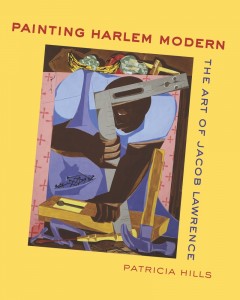 In Painting Harlem Modern, Patricia Hills renders a vivid assessment of Lawrence’s long and productive career. She argues that his complex, cubist-based paintings developed out of a vital connection with a modern Harlem that was filled with artists, writers, musicians, and social activists. She also uniquely positions Lawrence alongside such important African American writers as Langston Hughes, Richard Wright, and Ralph Ellison. Drawing from a wide range of archival materials and interviews with artists, Hills interprets Lawrence’s art as distilled from a life of struggle and perseverance.
In Painting Harlem Modern, Patricia Hills renders a vivid assessment of Lawrence’s long and productive career. She argues that his complex, cubist-based paintings developed out of a vital connection with a modern Harlem that was filled with artists, writers, musicians, and social activists. She also uniquely positions Lawrence alongside such important African American writers as Langston Hughes, Richard Wright, and Ralph Ellison. Drawing from a wide range of archival materials and interviews with artists, Hills interprets Lawrence’s art as distilled from a life of struggle and perseverance.
She brings insightful analysis to his work, beginning with the 1930s street scenes that provided Harlem with its pictorial image, and follows each decade of Lawrence’s work, with accounts that include his impressions of Southern Jim Crow segregation and a groundbreaking discussion of Lawrence’s symbolic use of masks and masking during the 1950s Cold War era. Painting Harlem Modern is an absorbing book that highlights Lawrence’s heroic efforts to meet his many challenges while remaining true to his humanist values and
artistic vision.
“Painting Harlem Modern offers new and valuable insight into how Harlem shaped art, and how art shaped Harlem. And as if Lawrence, art, and Harlem weren’t enough, Hills also explores the creation of modern black identity. This book is a major contribution not only to African American art history but to African American history in general.”
—Henry Louis Gates Jr., author of In Search of Our Roots
“The triumphant result of years of exhaustive scholarship, Hills’s book emerges as the definitive treatment of the life and work of one of America’s great artists. Lucidly written and deftly illustrated, it is an essential text for specialists and an enjoyable education for anyone interested in Jacob Lawrence and modern American art.”
—Orlando Patterson, Harvard University
“Viewing Lawrence’s Harlem as the Parnassus of African American arts and letters and, related to this, the conceptual site where the painter created his own template for a socially grounded modernism, Hills calls for a reevaluation of this pivotal artist and for a sustained interrogation of his complex, visually layered pictures. For her critical and erudite intercession, art history should be forever indebted.”
—Richard J. Powell, author of Cutting a Figure
“A long overdue study that will likely become the definitive work on this seminal figure in American art.”
—Mary Ann Calo, Colgate University
